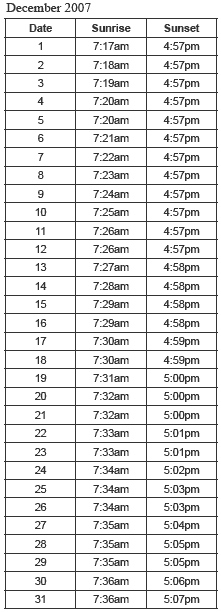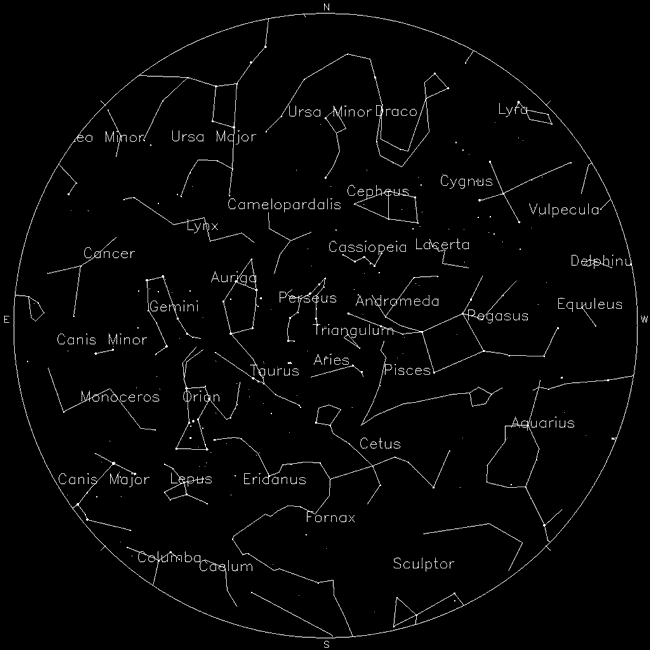DAYLIGHT
Day
length changes little around the solstice (the shortest
period of daylight) because the sun appears to move towards
the east as the Earth passes through the elliptical end
of its orbit. However, the latest sunrise and earliest
sunset do not occur on the same date. The earliest sunset
occurs almost two weeks before the winter solstice, while
the latest sunrise occurs in January. In December the sun
sinks low in the sky which
Moab UT (at
City Hall)
38O34’ N Latitude
109O33’ W Longitude
4048 ft - 1234 m |
|
 |
MAJOR
CONSTELLATIONS OF NOVEMBER |
Overhead
Andromeda
Aries
Pegasus
Perseus
Pisces
Northward
Cassiopeia
Cepheus
Ursa Major
Ursa Minor
Eastward
Auriga
Canis Major
Canis Minor
Gemini
Orion
Taurus
|
Southward
Aquarius
Cetus
Westward
Cygnus
Lyra
|
causes later sunrises
and earlier sunsets. However, from November to February,
the tilt of the Earth’s axis and its increased speed as it approaches
perihelion (point nearest to sun) make the solar day a
little longer than a 24 hour clock day. The difference
can be detected at solar noon, when the sun reaches its
zenith after 12 noon clock time. By early December solar
noon is delayed enough to postpone the time of sunset by
a few seconds each day. After the solstice, sunrise should
begin to occur earlier as the sun begins to move higher
in the sky. However, the longer solar day continues to
delay sunrise, solar noon, and sunset. By early January
the sun’s position in the sky has risen high enough
to override the effect of the longer solar day. At that
point the sun begins to rise earlier each day.
MOON HAPPENINGS
December 1 begins with a third quarter moon high in the morning
sky just below Saturn. On the morning of December 5 the waning
moon will appear alongside Venus and the bright star Spica
in the constellation Virgo. New Moon occurs on December 9 at
10:41am. The 13th Full Moon (we had two in May) of the year
occurs at 6:16pm on December 23. It rises with a still brilliant
Mars in the eastern sky just before sunset. On the evening
of December 27, a waning gibbous moon rises less than one degree
from the bright star Regulus in the constellation Leo. Look
for them around 10:00pm. Saturn rises about one-half hour later.
METEOR SHOWERS
The Geminid Meteor Shower is one of the most rewarding displays
of the year, producing 60 or more meteors per hour. Increased
meteor activity in the vicinity of Gemini is evident from December
6-19. A waxing crescent moon sets by 8:00pm, leaving dark skies
for viewing this abundant, colorful meteor shower. Look eastward
towards Gemini (highlighted by the bright red planet, Mars)
soon after sunset. Peak viewing occurs after midnight, on December
13, when Gemini is overhead. A more moderate meteor shower
occurs to the north, in late December, between Ursa Major and
Ursa Minor. The Ursid Meteor Shower produces around 10 meteors
per hour and peaks on December 22. The source of this meteor
activity is from previous passes of Comet Tuttle (see COMET
VIEWING).
COMET VIEWING
Be sure to check the progress of Comet 17P/Holmes as it passes
through Perseus during December. Its outburst of dust and ice
on October 24, 2007, increased its brightness by a million
times in just a few days. By mid-November the diameter of the
dust and ice cloud forming its coma was larger than the diameter
of the sun. Comet Holmes went through a similar outburst and
increase in brightness in 1892 when it was first discovered.
Normally it is no brighter than the planet Pluto. The comet
is fading in brilliance as it expands, but it could repeat
its performance of 1892 when the first outburst was followed
by another a few months later. Comet Holmes has an orbital
period of seven years. Another Comet, 8P/Tuttle, is due to
rendezvous with the sun around the beginning of the new year.
Look for it as it passes through Cassiopeia and Andromeda during
December. Its brilliance is similar to that of a dim star when
viewed with the unaided eye. Comet Tuttle, with a period of
13.6 years, is the source of the Ursid Meteor Shower.
VISIBLE PLANETS
Jupiter - disappears from the evening
sky by December 7 as its orbit takes it behind the sun;
reaches conjunction with the sun (opposite side of sun
from Earth) on December 23, but we will not see it; reappears
in the morning sky in January.
Mars - at its nearest and brightest for the
next nine years on December 18; outshines all the planets but
Venus; due south at midnight on December 24 when it reaches opposition
(opposite side of Earth from sun).
Saturn - rises before midnight throughout the
month and visible high in the morning sky above Venus; on the
morning of December 1 look for Saturn just 2 degrees above the
waning third quarter moon (that is a little more than the width
of your little finger held at arm’s length).
Venus - shines brightly as the morning star
throughout the month; on the morning of December 5 a waning crescent
moon hovers near Venus and Spica (brightest star in Virgo).
WINTER SOLSTICE
Winter begins in Moab on December 21 at 11:08pm. The solstice
occurs when the sun’s path across the sky reaches
its lowest point in the southern sky. Seasonal changes
occur because the Earth’s axis tilts away from the
plane of its orbit at a 23.5 degree angle. In winter that
means the northern hemisphere tilts away from the sun so
that the sun’s rays strike the Earth at a shallow
angle. Even though the sun is closer to the earth in winter
than in summer, much of its heat is lost as it passes through
more atmosphere and is dispersed over a greater area. |

